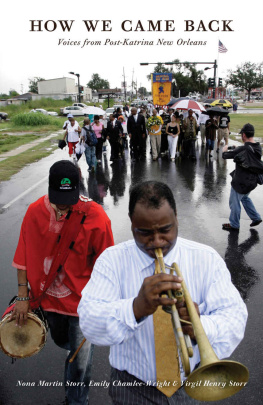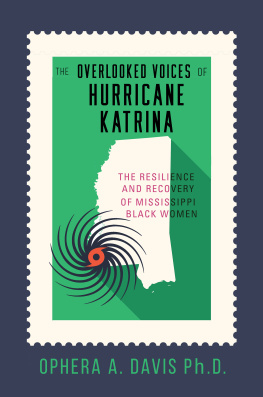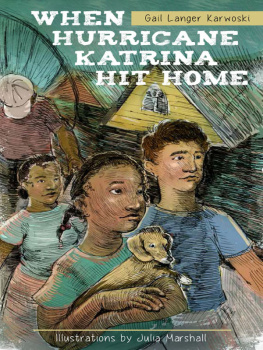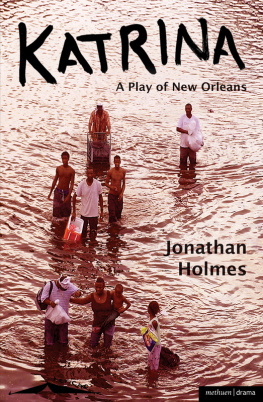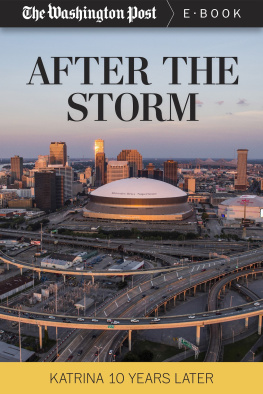Copyright 2015 by Nona Martin Storr, Emily Chamlee-Wright, Virgil Henry Storr, and the Mercatus Center at George Mason University.
All rights reserved.
Typesetting by Thomas J. Piwowar & Associates, Inc.
Storr, Nona Martin.
How we came back : voices from post-Katrina New Orleans / by Nona Martin Storr, Emily Chamlee-Wright, and Virgil Henry Storr.
1. Neighborhoods -- Louisiana -- New Orleans -- History -- 21st century. 2. Hurricane Katrina, 2005 -- Social aspects -- Louisiana -- New Orleans. 3. Urban renewal -- Louisiana -- New Orleans -- History -- 21st century. 4. Disaster relief -- Louisiana -- New Orleans -- History -- 21st century. 5. Community life -- Louisiana -- New Orleans -- History -- 21st century. 6. Disaster victims -- Louisiana -- New Orleans -- Biography. 7. New Orleans (La.) -- Biography. 8. New Orleans (La.) -- Social conditions -- 21st century. 9. New Orleans (La.) -- Social life and customs -- 21st century. I. Chamlee-Wright, Emily, 1966- II. Storr, Virgil Henry, 1975- III. Title.
Foreword
THE ANATOMY OF RECOVERY
N ona Martin Storr, Emily Chamlee-Wright, and Virgil Henry Storr have compiled an intimate and detailed account of the trials and tribulations the people of New Orleans encountered in trying to rebuild their businesses, their churches, their communities, their families, and ultimately their lives after Hurricane Katrina. How We Came Backis a collection of oral histories that explores how individuals strive to resume normal life after a disaster.
As the principal investor of the broader project of which this volume is a part, I could not be prouder. When I started my social science career as an economist in the field of Sovietology, one of my strongest influences methodologically was Alain Besanons essay Anatomy of a Spectre. As he argued,
The Soviet economy is the subject of a considerable volume of scholarly work which occupies numerous study centers in Europe and the United States and which provides material for a vast literature and various academic journals. But those born in the Soviet Union or those who approach Soviet society through history, literature, travel or through listening to what the migrs have to say, find that they cannot recognize what the economists describe.There seems to be an unbridgeable gap between this system, conceived through measurements and figures, and the other system, without measurements or figures, which they have come to know through intuition and their own actual experience.
With the encouragement of my advisor at George Mason University, economist Don Lavoie, I started to think of ways to analytically combine a form of rational choice institutionalism (praxeology broadly understood) with more narrative and interpretative empirical work (Verstehenbroadly understood). This approach to understanding social phenomena respects the past and recognizes the value of listening to the stories people tell themselves and tell others about themselves. It also recognizes the importance of economic ethnography, which is critical to pursuing what economist and historian Deirdre McCloskey has described as an empirical yet Austrian economics. This approach maintains the argumentative structure of rational choice institutionalism, but it uses that analytical framework to interpret human action from the purposes, plans, and understanding of the actors themselves in their unique circumstances. We must listen and learn from those on the ground.
In addition to Besanons work in Sovietology, which suggested ethnography as a viable empirical strategy, I was also deeply influenced by the work of Nobel Prizewinning economist Elinor Ostrom on the nature of the rules in use as opposed to the stated, formal rules that constitute the working institutions in the rational choice institutionalism framework. She, too, focused on the informal sector on the ground.
The informal economy became a major theme of my research on the workings of the Soviet-type economy as well as the starting point for the analysis of that systems reform that occupied my research efforts for much of the 1990s. The lessons from the Soviet experience expand beyond the fields of Sovietology and comparative economic systems. They lead to radically rethinking the entire project of political economy and the economics of everyday life.
Virgil Storr and I wrote a paper about what we called at the time post-classical political economy. We emphasized the triple embeddedness of social action, in which the economic and financial aspects of human action overlap with the political and legal aspects as well as the social and cultural aspects. A proper political economy analysis, we argued, cannot ignore the embeddedness of human action and the pattern of exchange and production relationships that emerges in that context. Outcomes, in short, are context dependent. Like Ostrom, we dont deny that we can learn from more formal structures in theory, or from more controlled settings in our empirics, but we insist, like Besanon and Ostrom, that a lot can be learned from the folks on the ground. Indeed, we need to listen and learn from the voices on the ground before we analyze and diagnose their situations with the aid of our theoretical framework, and we need to evaluate the analytic narratives we construct against this ultimate empirical check: the beliefs, thoughts, aspirations, and meanings of those living the experience we are trying to analyze.
Influenced by this perspective, shortly after 2000, the Mercatus Center at George Mason University formed a research team to examine the role of institutions in economic development and the political economy of transitioning economies. For several years, we had research teams in less developed countries and in transitioning economies. Members of the research team published journal articles, dissertations, and books addressing issues in countries from the Czech Republic to China, from emerging markets to failed and weak states. From 2000 through 2005, this group was very productive, and we learned a lot from our on-the-ground research about the political economy of everyday life and the prospects and perils of economic reform efforts.
The critical next move was to examine disasters and disaster recovery using the tools of economics. Disaster economics is a sub-branch of development economics. In August 2005, as we saw the horrific events caused by Hurricane Katrinas landfall on the Gulf Coast, we committed to studying the recovery process over the next five years to learn what we could about how resilient communities were, how they rebuild social relationships that have literally washed away, and how this rebuilding occurs at the intersection of economic and financial institutions, political and legal institutions, and social and cultural institutions. The paper that Storr and I published in 2002 in the

